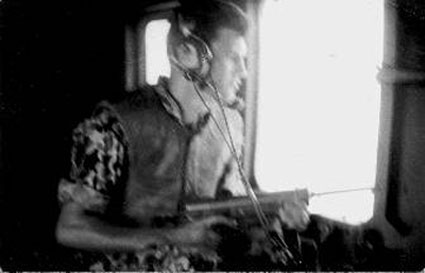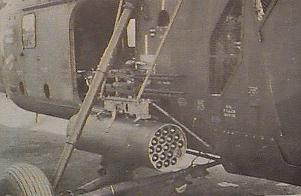History Of The UH-34D Stinger Gunship
.
"The History of the UH-34D Stinger" was revised on 20 December 2007
by Alan Weiss with permission from
George McKee
&
Willard Reeves Jr.
Article from Helis.com
Story
provided by George McKee
&
Willard Reeves Jr.
The Sea Horse primary
role was personnel and cargo transport. The aircraft were "slick" meaning that
they had no weapons but by August 1962 some squadrons had, M-60 machine guns were mounted inside
the aircraft. Two machine guns were utilized: one for the crew chief, mounted at
the main door and one mounted in the rear window on the opposite side for use of
the gunner. Very often the pilot and co-pilot carried an AR15, which was the
forerunner of today 's M16 rifle, next to their seat in the cockpit which
allowed them to provide fire support if they were not on the controls.
 Gunner George DeBarge HMM-361 Shufly 1963 with AR15
Gunner George DeBarge HMM-361 Shufly 1963 with AR15
The US Army, with a
small unit deployed in Da Nang, had
Bell UH-1B (at that time HU-1B ) aircraft configured as gunships and
would serve as escorts when there own commitments allowed. UH-1B aircraft for
Marine use was still in the future; the UH-1E specialized Marines version of the
Huey arrived in 1966.
The army UH-1B was a little underpowered for the role they were playing and must
be remembered, was also an experiment for the US Army . The extra weight
of several boxes of ammunition and the extra crewmembers to maintain a constant
flow of ammunition and manning extra M-60 machine guns caused the UH-1B to be
slow and with limited range. This was because of the need to cut back on the
amount of fuel carried to allow for the extra weight. A strike of any distance
would require a refueling stop for the UH-1B along the route while the UH-34
circled.
 photo from Helis.com
photo from Helis.com
All these reasons,
along with the limited amount of aircraft the army had, resulted in the Marine
Corps Development Center at Quantico experimenting with some method of providing
the Marine Corps a means of escorting themselves.
The method decided on was to arm the UH-34.
UH-34s' were modified
by mounting two fixed, forward firing M-60 machine guns attached to the landing
gear on the right side and two 2.75" FFAR ( Folding Fin Aerial Rocket ) pods
attached between the landing gear struts on each side of the aircraft. Both rear
windows now had an M-60 machine gun installed and one in the door for the crew
chief. The rockets' sighting system was very primitive but useable. It consisted
of a grease pencil mark on the windshield and a cross hair welded inside a
circle mounted to the instrument panel and windshield with nuts and bolts. The
system required the cross hair in the circle be lined up with the grease pencil
and the target. What it lacked in sophistication, it made up in reliability.
Pilots who flew them began to hit targets consistently, after a little
practice. The armed H-34s,
called Stingers had only four aircraft modified. They were all assigned
to HMM-365 commanded by Lt.Col. Joseph Koler and was the first Marine helicopter
unit to utilize a piston powered helicopter as a gunship.
Due to the urgency of
the war and the lack of gunships another Marine Corps UH-34 squadron HMM-162 had
some TK-1 Stingers kits installed on some aircraft. Our aircraft Buno 150570
(YS-19) was a Stinger gunship while in HMM-162.
Many problems plagued
the conversion and perhaps the mounting design was the major of them. With the
rigid mounts, neither the machine guns nor the rockets could be aimed without
the entire helicopter being pointed in the direction of the target. This made
for some pretty unusual flying altitudes trying to line up the cross-hair with
the dot by pointing the aircraft....and by the way...while, usually, presenting
a pretty big bulls-eye for the target.
The UH-34 was a
relatively large, slow aircraft and the target usually got some pretty good
shots at the gunship. All these factors contributed to an unusually number of
Stingers damaged by ground fire. The US Army solved this problem in later
versions of the UH-1B by mounting their armament on swivels that could be aimed
in a direction other than the one the aircraft was pointed.
In spite of all the
limitations, the US Marines used the Stingers effectively and extensively but
the days of piston powered aircraft were numbered and the decision was made to
discontinue the experiment. Turbine powered aircraft was the future of
helicopter warfare.
As soon as the US Army got some more armed UH-1Bs to Da Nang to support the
marines increased flight operations, the Stingers were striped of their forward
firing armament returning to a transport configuration and became but a footnote
in history.
Special thanks to
George McKee
&
Willard Reeves Jr.
 PLEASE
CLICK HERE TO BECOME A MEMBER PLEASE
CLICK HERE TO BECOME A MEMBER
FREEDOM'S FLYING MEMORIAL
P.O. Box 429
Cutchogue, NY 11935
Contact Alan Weiss 631-827-5526
Web site and all contents © Copyright of Freedom's Flying Memorial
2007, All rights reserved.
|